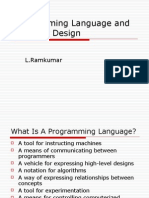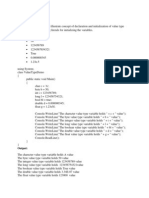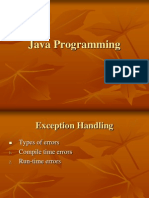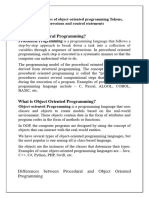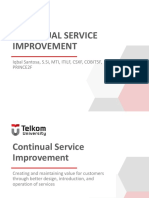Programming Paradigms
Uploaded by
rohitkhilnaniProgramming Paradigms
Uploaded by
rohitkhilnanihttp://cplusplusatoz.blogspot.
in/
Programming Paradigms
http://cplusplusatoz.blogspot.in/
Programming paradigms have consistently evolved into a better form, whenever there has been a need.
Monolithic Programming
This approach involved writing programs with relatively flat structure. Program flow control was achieved only through jump statements (similar to goto statement in C++). This made the program structure extremely complex, leading to spaghetti code. There was no support for subroutines. Code needed to be replicated whenever same functionality was required to be performed. Program could consist of only global data. This approach was suitable only for small applications. Example : BASIC
Procedural Programming
As the complexity of programs increased, Monolithic Programming could no longer serve the need. As a consequence, Procedural Programming evolved. The task to be performed by the program was to be broken down into a series of steps, which when performed in sequential order, would result in the desired output. Another name for Procedural Programming is Imperative Programming. Example : Fortran
http://cplusplusatoz.blogspot.in/
http://cplusplusatoz.blogspot.in/
Structured Programming
Even more complex programs, which could not be handled by Procedural Programming, were handled well by Structured Programming. This approach provided support for stand alone subroutines, which eliminated the problem of replicating code whenever an already performed functionality needed to be repeated. Support for local variables was there. Rich control structures were supported, which reduced and in fact, almost eliminated the reliance on jump statements like goto. The programs were organised around their Code . This approach can be thought of as "Code acting on Data". Example : C
Object Oriented Programming
Increasing complexity of programs lead to the evolution of Object Oriented Approach. In this approach, programs are organised around Data. It can be thought of as "Data being acted upon by Code". The type of data defines which code/method can act on it. All Object Oriented languages support three features : Encapsulation, Inheritance & Polymorphism. Example : C++ & Java
Encapsulation
Encapsulation is the mechanism of binding together code and data it manipulates, keeping them safe from external interference and misuse. The concept of Classes is used to support this behaviour. Inside a class, members may be private or public. Public members can still be accessed from outside the class but private members can be accessed only from within the class. The public members provide an interface to the private members of the class.
http://cplusplusatoz.blogspot.in/
http://cplusplusatoz.blogspot.in/
Inheritance
Inheritance is the process which allows on object to acquire properties of another object. This allows for the concept of classification. It becomes easier to think of information as divided into various classes hierarchically. Without classification, all objects would need to be described entirely. However, with classification we can define only the new characteristics which make the object unique within its class.
Polymorphism
Polymorphism is the process in which one interface is used to perform different actions depending upon the context of the situation. For example, a single function name 'area' may be used to calculate the area of more than one kind of objects (figures). C++ supports two kinds of Polymorphism :
Compile time (Static Binding)
Compile time Polymorphism is achieved through Function & Operator Overloading. The Function calls (or bindings) are resolved at compile time.
Run time (Dynamic Binding)
Run time Polymorphism is achieved through Virtual Functions & Inheritance. The Function calls are resolved at Run time.
http://cplusplusatoz.blogspot.in/
http://cplusplusatoz.blogspot.in/
Abstraction & Data Hiding
Abstraction is the process of defining data & program with representation similar to their meaning. Only the relevant details need to be exposed, keeping the rest of the detail safe. Abstraction may be of two kinds :
Control Abstraction : Exposing only the required actions and hiding the rest. For
example, there are private and public member functions inside a class. The public members are accessible outside the class but access to private members outside the class is restricted.
Data Abstraction : Exposing only the required data and hiding the rest. Like
functions, a class may have both public and private data. Private data is not accessible outside the class, unlike public data. This process of hiding some parts of data is also called Data Hiding.
More topics on C++ at the URL given on top.
http://cplusplusatoz.blogspot.in/
You might also like
- Practical 1:-Familiarization With Programming Environment100% (1)Practical 1:-Familiarization With Programming Environment3 pages
- Programming Language and Compiler Design SessionNo ratings yetProgramming Language and Compiler Design Session33 pages
- CS449 - Syllabus-Algorithms & ComplexityNo ratings yetCS449 - Syllabus-Algorithms & Complexity5 pages
- Introduction To The Linux Operating SystemNo ratings yetIntroduction To The Linux Operating System5 pages
- Introduction To Programming and Algorithms Cat 2100% (1)Introduction To Programming and Algorithms Cat 210 pages
- OOPJ2 - Module 1 - Introduction To Object Oriented ProgrammingNo ratings yetOOPJ2 - Module 1 - Introduction To Object Oriented Programming76 pages
- 01 ELMS Activity 1 (In Computer Engineering As A Discipline)No ratings yet01 ELMS Activity 1 (In Computer Engineering As A Discipline)1 page
- Chapter2 - Machine Instructions and ProgramsNo ratings yetChapter2 - Machine Instructions and Programs85 pages
- 8.introduction To C# Window Form ApplicationNo ratings yet8.introduction To C# Window Form Application10 pages
- Lec - 2 - Analysis of Algorithms (Part 2)No ratings yetLec - 2 - Analysis of Algorithms (Part 2)45 pages
- DE Unit 3 Combinational Circuits - 13112017 - 024114AM PDFNo ratings yetDE Unit 3 Combinational Circuits - 13112017 - 024114AM PDF16 pages
- Equity of Cybersecurity in the Education System: High Schools, Undergraduate, Graduate and Post-Graduate Studies.From EverandEquity of Cybersecurity in the Education System: High Schools, Undergraduate, Graduate and Post-Graduate Studies.No ratings yet
- Best Practices in Capital Equipment CommissioningNo ratings yetBest Practices in Capital Equipment Commissioning8 pages
- 5 BM-03 Composite Function BM-03 Worksheet-02No ratings yet5 BM-03 Composite Function BM-03 Worksheet-024 pages
- Paints Industry Raw Materials Unit Operations Equipment Manufacturing Quality TestsNo ratings yetPaints Industry Raw Materials Unit Operations Equipment Manufacturing Quality Tests46 pages
- A Project Report Automatic Traffic Light Prepared in Partial FulfillmentNo ratings yetA Project Report Automatic Traffic Light Prepared in Partial Fulfillment6 pages
- Volkswagen Workshop Service and Repair Manuals _ Golf Mk4 _ Power unit _ 4-cylinder diesel engine with unit injector _ Engine cooling _ Removing and installing parts of cooling system _ Parts of cooling system - engine sideNo ratings yetVolkswagen Workshop Service and Repair Manuals _ Golf Mk4 _ Power unit _ 4-cylinder diesel engine with unit injector _ Engine cooling _ Removing and installing parts of cooling system _ Parts of cooling system - engine side3 pages
- Steel Pipe Pile Unit Weights - Marine - Pile - FoundationsNo ratings yetSteel Pipe Pile Unit Weights - Marine - Pile - Foundations1 page
- AEE 334 Experiment #3: Flame Stability and Flame Speed ObjectiveNo ratings yetAEE 334 Experiment #3: Flame Stability and Flame Speed Objective3 pages
- Glued Laminated Timber - Performance Requirements and Minimum Production RequirementsNo ratings yetGlued Laminated Timber - Performance Requirements and Minimum Production Requirements18 pages
- PSTC-8 - Unwind Force of Pressure Sensitive TapeNo ratings yetPSTC-8 - Unwind Force of Pressure Sensitive Tape2 pages
- Royal Institution of Surveyors Malaysia Building Cost Information CentreNo ratings yetRoyal Institution of Surveyors Malaysia Building Cost Information Centre1 page



